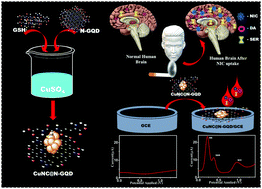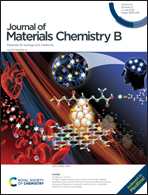A highly stable copper nano cluster on nitrogen-doped graphene quantum dots for the simultaneous electrochemical sensing of dopamine, serotonin, and nicotine: a possible addiction scrutinizing strategy†
Abstract
A highly stable copper (Cu) nanocluster (NC), which exhibited stability for more than one year, was synthesized using nitrogen-doped graphene quantum dots (N-GQDs) as reducing and capping agents and smaller glutathione molecules as additional capping agents. The synthesized NC, CuNC@N-GQDs, successfully sensed dopamine (DA), serotonin (SER), and nicotine (NIC) simultaneously with well-defined peaks and good peak-to-peak separation, whereas none of the controls including CuNCs and N-GQDs exhibited the simultaneous sensing properties. In addition, they exhibited enhanced sensitivity with current responses ∼4, ∼4, and ∼2 times those of the corresponding control for DA, SER, and NIC. The limits of detection obtained were 0.001, 1.00, and 0.01 nM for DA, SER, and NIC, respectively. The higher sensitivity and the simultaneous sensing are indicative of the synergistic effect of CuNCs and N-GQDs in the CuNC@N-GQDs. The sensing performance was successfully extended to real blood and urine samples spiked with DA, SER, and NIC.



 Please wait while we load your content...
Please wait while we load your content...